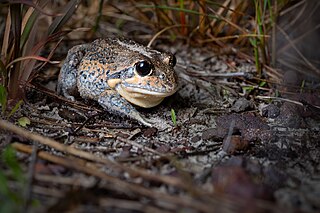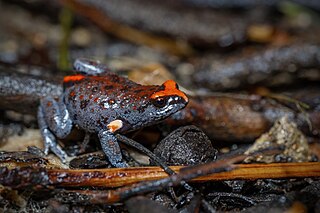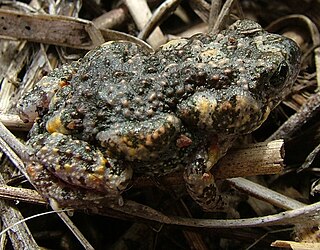
Limnodynastes dumerilii is a frog species from the family Limnodynastidae. The informal names for the species and its subspecies include eastern or southern banjo frog, and bull frog. The frog is also called the pobblebonk after its distinctive "bonk" call, which is likened to a banjo string being plucked. There are five subspecies of L. dumerilii, each with different skin coloration. The species is native to eastern Australia. There has been one occurrence in New Zealand, when tadpoles of the species were found in 1999 and destroyed.

The red-crowned toadlet is a species of Australian ground frog, restricted to the Sydney Basin, New South Wales. It is only found around sandstone escarpment areas around Sydney, from Ourimbah in the north, Nowra to the south and the Blue Mountains areas to the west.

Arenophryne is a small genus of Myobatrachid frogs from coastal Western Australia. Common names sandhill frogs and Australian dumpy frogs have been coined for it.

Amphibians of Australia are limited to members of the order Anura, commonly known as frogs. All Australian frogs are in the suborder Neobatrachia, also known as the modern frogs, which make up the largest proportion of extant frog species. About 230 of the 5,280 species of frog are native to Australia with 93% of them endemic. Compared with other continents, species diversity is low, and may be related to the climate of most of the Australian continent. There are two known invasive amphibians, the cane toad and the smooth newt.

Metacrinia is a genus of frog in the family Myobatrachidae. It is monotypic, being represented by the single species, Metacrinia nichollsi, commonly known as the Forest toadlet or Nicholls toadlet. It is endemic to Southwest Australia, occurring between Dunsborough and Albany.

The desert tree frog, or little red tree frog, is a species of tree frog native to Australia, southern New Guinea, and Timor. It is one of Australia's most widely distributed frogs, inhabiting northern Australia, including desert regions and much of temperate eastern Australia. It is one of the few Australian tree frogs to inhabit arid, tropical, and temperate climates.

The Sudell's frog, painted burrowing frog, trilling frog or desert trilling frog is a species of burrowing frog common to a large part of southeastern Australia. It is found on and west of the Great Dividing Range of New South Wales to western Victoria and southern Queensland, as well as far eastern South Australia, and southern regions of the Northern Territory.

The wrinkled toadlet is a species of small, ground-dwelling frog in the family Myobatrachidae It is endemic to Australia. It is also commonly called the small-headed toadlet, red-groined toadlet or the chubby gungan.
The streambank froglet or Flinders Ranges froglet is a small, locally common, Australian ground-dwelling frog, of the family Myobatrachidae.

The marbled frog or marbled marsh frog is a species of ground-dwelling frog native to northern and north-eastern Australia, and southern New Guinea in both Indonesia and Papua New Guinea.

Ranoidea platycephala, is a species of frog that is common in most Australian states and territories and is commonly referred to as the water-holding frog but has also been referred to as the eastern water-holding frog, and the common water holding frog. This species belongs to the Pelodryadinae subfamily of the Hylidae family but differs from most other members of this subfamily as it is a ground dweller and undertakes aestivation.

Myobatrachus is a genus of frogs found in Western Australia. It is monotypic, being represented by the single species, Myobatrachus gouldii, also known as the turtle frog. It gets its name from the resemblance to a shell-less chelonian, which is a type of turtle. It is described to have an extremely small narrow head, short limbs, and a round body. They can get up to 45 millimetres (1.8 in) long. Anatomy studies of this species say that it has an incredibly large pectoral girdle for its size. Due to its unusual morphology, the features of this creature are thought to originate with old frog lineages from the early Tertiary or late Mesozoic eras.

Copland's rock frog or the saxicoline tree frog is a species of frog in the subfamily Pelodryadinae. It is endemic to Australia, in a range extending from the Kimberley region of Western Australia to Arnhem Land and a record in the north of Queensland. Its natural habitats are subtropical or tropical dry shrubland, subtropical or tropical dry lowland grassland, intermittent rivers, and rocky areas.

The Wotjulum frog is a species of frog in the subfamily Pelodryadinae. Its habitats are subtropical or tropical dry forests, subtropical or tropical moist lowland forests, subtropical or tropical swamps, rivers, intermittent rivers, swamps, freshwater lakes, freshwater marshes, intermittent freshwater marshes, and rocky areas.
The hooting frog is a species of frog in the family Limnodynastidae. It is endemic to Australia. Its natural habitats are temperate forests and intermittent rivers.
The northern burrowing frog is a species of frog in the family Limnodynastidae. It is endemic to Australia. Its natural habitats are subtropical or tropical dry shrubland, subtropical or tropical dry lowland grassland, subtropical or tropical seasonally wet or flooded lowland grassland, and intermittent freshwater marshes.

The humming frog is a species of frog in the family Limnodynastidae. It is endemic to Australia. Its natural habitats are temperate forests, temperate shrubland, Mediterranean-type shrubby vegetation, intermittent freshwater marshes, rocky areas, arable land, pastureland and open excavations.

The northern spadefoot toad is a species of frog in the family Limnodynastidae.

The desert spadefoot toad is a species of frog in the family Limnodynastidae. It is endemic to Australia. Its natural habitats are subtropical or tropical dry shrubland, subtropical or tropical dry lowland grassland, intermittent freshwater marshes, hot deserts, and temperate desert.
Douglas' toad is a species of frog in the family Myobatrachidae. It is endemic to Western Australia. Its natural habitats are dry savanna, moist savanna, subtropical or tropical dry shrubland, rivers, freshwater marshes, freshwater springs, and rocky areas.


















